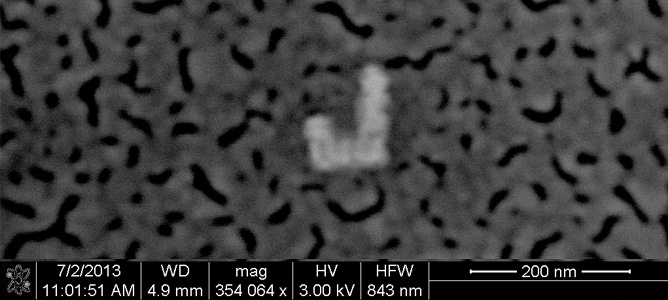Nanoscale antennas the future of telecommunications

Scanning Electron Microscopy image of a 30nm thick silver J-pole antenna fabricated on glass with a thin gold coating. Dimensions: width 30nm, long arm length 120nm, short arm length 60nm.
July 2013
Researchers from the University of Melbourne and CSIRO, including Dr Tim James, Dr. Tim Davis and Associate Professor Ann Robertts, together with MCN Senior Process Engineer, Matteo Altissimo have developed nanometer sized optical anteanna based on every-day radio frequency designs. The novel designs explored are focused enhancing radiation from a single photon emitter, critical components in secure optical telecommunications systems and novel biosensing systems.
The nano-antenna structures, specifically the J-pole optical antennas, were fabricated at the MCN using the Vistec EBPG 5000 electron beam lithography (EBL) system, with very high resolution EBL resist, which enabled the 30nm minimum feature sizes to be achieved.
The ability to fabricate optical nano-structures of such high fidelity enables Australian researchers to create nano-optical devices at world-class standards. This will enable novel technologies such as high efficiency single photon sources to be developed locally which is the aim of this project, but more broadly facilitates the research into leading edge nano optical devices.
The presented J-pole presents the first step in the project to develop a high-efficiency single photon source which is critical to enhancing biological research and the security of telecommunications systems.
The team will next look at integration of the nano-antenna structures with single-photon sources such as NV centres in nano-diamond and inorganic quantum dots, which again requires the high precision and accuracy provided by the EBL tool at the MCN.


